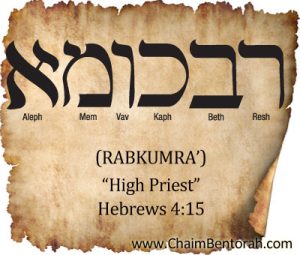ARAMAIC WORD STUDY – HIGH PRIEST – RABKUMRA’ רבכומא
Hebrews 4:15: “For we have not an high priest which cannot be touched with the feeling of our infirmities; but was in all points tempted like as [we are, yet] without sin.”
 I have often wondered why Paul pictures Jesus as a High Priest who understands our infirmities. In Judaism, the office of the High Priest ended with the destruction of the second temple in 70 AD. For us Christians, it ended with the death and resurrection of Jesus who became our High Priest. Have you ever wondered just what that meant that Jesus is our High Priest? High Priest in the Aramaic in reference to Jesus is rabkumra which is translated as High Priest but is made up of the words rab where we get rabbi, which means master or chief and kumra which is from the root word kamar which has the idea of shrinkage or humility. The Hebrew word for High Priest is kohan gadol the great or chief priest. The word in Greek is archierea. You may recognize the word arch and means the chief (priest).
I have often wondered why Paul pictures Jesus as a High Priest who understands our infirmities. In Judaism, the office of the High Priest ended with the destruction of the second temple in 70 AD. For us Christians, it ended with the death and resurrection of Jesus who became our High Priest. Have you ever wondered just what that meant that Jesus is our High Priest? High Priest in the Aramaic in reference to Jesus is rabkumra which is translated as High Priest but is made up of the words rab where we get rabbi, which means master or chief and kumra which is from the root word kamar which has the idea of shrinkage or humility. The Hebrew word for High Priest is kohan gadol the great or chief priest. The word in Greek is archierea. You may recognize the word arch and means the chief (priest).
Here is what I find interesting in the Aramaic. The Aramaic word used in the Gospels for high priest is simply raba which is the word for rabbi. It does not include the word kumra. The role of Jesus is just not that of the High Priest but the High Priest who is humble, who has lowered Himself. You see Jesus is the Son of God, to be a High Priest in terms of rank on a heavenly level is pretty low, lower than the angels. To be our Savior, however, He had to lower Himself to the rank of High Priest. He had to take a demotion, kumra, shrink down to the level of a human to assume the position of High Priest.
By why a High Priest. I did some checking in the Talmud and discovered some amazing things. For one thing only, as we all know, the High Priest enters the Holy of Holies on the Day of Atonement when he offers a sacrifice for the sin of all the people. He literally takes on the sins of the entire nation as Jesus took on the sins of the entire world. But here is something you may not know that I found interesting in the Talmud Yoma 18a is that the High Priest had to be rich. If he were not it was up to the other priest to make sure he was rich. He had to be superior to everyone in his wealth, his physique, his wisdom, and his dignity. Remember Luke 2:52 “And Jesus increased in wisdom and stature, and in favour with God and man.” That is exactly the requirement laid down in the Talmud for a High Priest. Although not materially wealthy He was superior in wealth in a spiritual sense. He also had to be married and married to only one woman. If his wife were to die before the Day of Atonement the High Priest had to remarry before he could offer the sacrifice on Yom Kippur. My study partner explained that one. Jesus as our High Priest is married to us. For the High Priest to be married, it meant he had to share his heart with his wife and make himself vulnerable to his wife as every man does with his wife when he gives her his heart. He gives her the ability to break his heart just as Jesus makes Himself vulnerable to us when He gives us His heart.
One other strange thing found in the Talmud in Sanhedrin 18a is that we find the wife of the High Priest had the right to divorce her husband and if she did she would be allowed to marry another man. In the Hebrew culture, only the man had the right to divorce, a woman could not get a divorce unless there were some really special circumstances. My study partner pointed out that this shows God’s loyalty to us. He will never divorce us once we are married to Him. We can divorce him and marry ourselves to other Gods, but God will remain faithful to us.
There are many other parallels between the High Priest and our Rabkumra High Priest Jesus which I will share with our All Access group ( https://www.chaimbentorah.com/all-access/ ) on our Saturday coffee time together.
There is one more thing, however, I would like to share. In the Talmud, Sanhedrin 4a we find that a High Priest cannot be seen disrobed or naked. This would occur when washing in the mikveh partial bathing or the tevilah the entire immersion. This was often not a private bath but a shared bath. This was not unusual as public bathhouses were common and even exist today. Not everyone had their own private bath in those days except for the High Priest. Now here is the catcher, the High Priest, however, could invite anyone he wants to share a bath with Him.
So what is the parallel of this to our Rabkumra High Priest Jesus? Again my study partner gave an explanation that I really like. This is again a picture of entering the heart of Jesus. Many are called few are chosen (Matthew 22:14). Many are born again but not all are invited to share the intimacy of a tevilah with Jesus. That is, not everyone seeks to develop their relationship with Jesus on a daily basis in prayer and Bible Study where they become such friends with Jesus that He will trust them enough to invite them to share the intimacy of His heart. Where Jesus shares the nakedness of His heart with us, reveals the deep mysteries of His heart He is truly Rabkumra who makes Himself vulnerable to us. Most Christians are like the people of Israel who refused to enter the cloud. Instead, they told Moses to go in the cloud and tell them what God has to say. God’s heart is available to everyone, but it is by invitation only, only to those who truly seek His heart on a daily basis, who search for Him with all their heart, soul and might Deuteronomy 4:29.








Very well said.